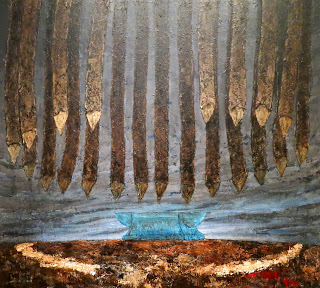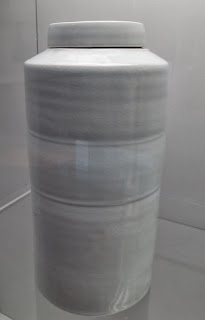Roderic O'Conor, Trees at Montigny, 1902 (oil on board)
Robert Bevan, Brimley Hill, Devon, 1915 (oil on canvas)
Bevan lived in Brittany in the 1890s where he worked alongside Paul Gauguin. His use of strong outlines and areas of flat colour was heavily influenced by Gauguin and other post-impressionist artists. In the 1900s he moved to London and became a member of the Camden Town Group of artists.
Christopher Nevinson, Summer in the Downs, before 1946 (oil on canvas)
Frank Salisbury, The Enchanted Road, 1927, (oil on canvas)
Paul Nash, The Stackyard, 1925 (oil on canvas)
Nash's use of colour and short, expressive brushstrokes in this painting show the influence of Paul Cezanne.
L.S. Lowry, Northleach Church, 1947 (oil on canvas)
A scene from the Cotswolds, a contrast to the heavily peopled northern industrial scenes for which he is best known.
Harry Norman, No. 1 Composition, 1938, (oil on board)
David Bomberg, Evening, Cornwall, Towards St Ives, 1947 (oil on canvas)
Joan Eardley, Glasgow Boy with Milk Bottle, 1948 (oil on canvas and board)
Eardley's works exposed child poverty in post-war Britain, particularly in slum areas.
L.S. Lowry, Ebbw Vale, 1960 (oil on canvas)
A mining town in South Wales, this is one of the largest pictures Lowry painted.
George Chapman, Miner Returning Home from Work, 1960, (oil on canvas)
The mining valleys of South Wales were the focus of Chapman's paintings. He saw his work as visual history and chose to depict the Rhondda Valley from the viewpoint of a stranger in the street. His paintings feature the simple shapes of the houses and streets of the mining villages, dominated by looming slag heaps in the distance.
Henri Matisse, Odalisque with a Dish of Fruit, 1925 (lithograph)
Henri Matisse, Two Female Figures, (lithograph)
Graham Sutherland, Final Trial Piece for Coventry Cathedral Tapestry, 1958 (wool tapestry)
Rosie Lee, It's Nice to be Nice II, 1969 (oil on canvas)
Many of Lee's paintings feature landscape gardens and sculpted hedges, often from perspectives that reveal only glimpses of what may lie beyond. In this painting the sense of seeing and not seeing is heightened. The faces of the figures are obscured and the person in the dark foreground is hidden from the view of the people in the sunny garden, lending an air of mystery to the scene.
George Wall, Wedge, 1972 (oil on canvas)
Gavin Jantjes, The first in the Korabra series, 1986, (acrylic, sand and pigment on canvas)
All the paintings in the Korabra series relate to slavery and use symbols to convey the suffering caused by the transatlantic slave trade. In this painting the stakes form a trap and represent the white people who took the slaves as prisoners from Africa. The anvil in the centre symbolises the process of hammering the leg irons and chains that bound the slaves.
John Keane, Scenes on the Road to Hell (V), 1991, (mixed media on paper)
John Keane was commissioned by the Imperial War Museum as an official war artist during the first Gulf War. In this painting he uses rapidly applied brushstrokes to evoke the chaos of the front line, in contrast to the more sanitised images that appeared on our television screens. He also references the increasingly voyeuristic nature of war reportage by showing a cameraman looming over the body of a dead soldier.
Ori Gersht, Afterwars, 1999, (photographic print mounted on aluminium)
The Afterwars series was made in and around Sarajevo in the aftermath of the conflict that saw the break-up of the former Yugoslavia in the 1900s. Each photograph shows the scars of war upon the landscape but also the re-building of life. Through the subtle and familiar signs of everyday life, this work explores how people strive to return to normality after conflict.
SPQR, Super Soft, 2010, (spray paint on canvas)
SPQR is a Bristol-based artist who works on the street and on canvas, using complex stencils, freehand spraying and screen prints. He feels that there has been a shift in perceptions of street art and that people are now much more willing to engage with it rather than seeing it as vandalism.
He sees his work as a form of protest, both against wider issues in society and against the intellectual snobbery of the traditional art world. Super Soft encourages the viewer to question the legal system and the role of the police in the UK today.
Peter Howson, Snow Road, 1995, (oil on canvas)
Peter Howson was the official war artist for the Bosnian war, visiting the region in 1993. Many of the drawings and paintings he produced were based on accounts of victims and witnesses.
This painting shows civilians, including small children, travelling down a road as armed soldiers force them on. Howson uses the ghostly, bleak landscape and a muted, cold palette to convey the sense of terror felt in Bosnia at the time, as a policy of ethnic cleansing was enforced. It also demonstrates Howson's own harrowing experience as a witness of war.
Bruce Maclean, Jug, 1987 (handbuilt earthenware)
Edmund de Waal, Lidded Jar, 2001 (porcelain)























Rachel has some Joan Eardley drawings of children, 4 I think, and they are very lovely.
ReplyDeleteI liked Glasgow Boy with Milk Bottle, it's very evocative.
Delete